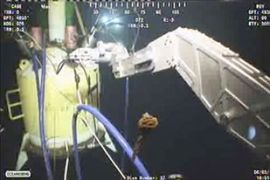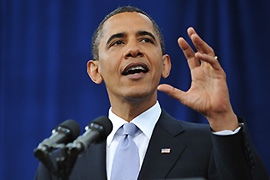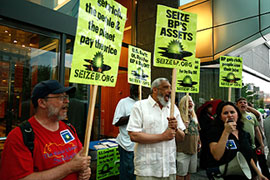Cap placed on ruptured US oil well
Engineers make progress in effort to stem oil leak as Obama hits out at BP response.

The operation follows a series of unsuccessful attempts to cap or contain the gushing leak since an explosion on April 20 tore through the BP-leased Deepwater Horizon rig just off the Louisiana coast.
Eleven oil workers died in the explosion.
Capturing oil
| in depth | |
|
The placing of the containment cap came hours after BP’s undersea robots managed to shear away the gushing well pipe that had protruded from the wellhead assembly, leaving a rough-hewn surface around the remaining hole.
Video of the blowout site some 1.6km below the surface appeared to show the white well cap manoeuvred onto the jagged top of the crippled wellhead assembly, while oil billowed from the sides of the apparatus.
Once the containment cap is in place, the plan is to start funnelling at least some of the escaping oil and gas into a large hose that would carry it from the bottom of the Gulf of Mexico to the surface, where it would be collected in ships and removed.
Earlier on Thursday Tony Hayward, BP’s chief executive, said severing the pipe was “an important milestone” but added that it would take 12-24 hours before the capping and siphoning process can be declared a success.
“We have cleared the riser from the top of the wellhead and the team is working to complete the cleanup operation before we put the cap on top of the well,” he said.
Hayward said it should be clear by Friday if the cap had been successfully put in place allowing oil to be funnelled to the surface.
An attempt last weekend to plug the well by forcing large quantities of drilling mud into the pipe – an operation known as “top kill” – failed to stop the leak.
Obama ‘furious’
BP has come under mounting pressure over its handling of the disaster and in an interview on Thursday Barack Obama said that he was “furious” about the spill, accusing the energy giant of failing to respond quickly enough.
 |
| Barack Obama said BP had failed to respond as rapidly to the crisis as he had expected [AFP] |
In an interview with CNN, the US president said BP had felt his anger over the spill but he added “ultimately this isn’t about me and how angry I am”.
“I would love to just spend a lot of my time venting and yelling at people. But that’s not the job I was hired to do. My job is to solve this problem.”
Obama said the spill was an example of a situation “where somebody didn’t think through the consequences of their actions”.
“This is imperilling an entire way of life and an entire region for potentially years”, he said, adding that he had not seen the kind of “rapid response” he would have expected from BP.
He also fended off criticism that his administration should be more directly involved in managing the spill, blaming a “mistake in understanding”.
Obama said while the US Coast Guard was responsible for coordinating relief efforts with BP, the government was reliant on the London-based energy firm for its expertise and equipment to plug the broken well.
“My job is to make sure that they are being held accountable, that we get to the bottom of how this happened, that they are paying what they’re supposed to be paying, that they cap this well,” he said.
In the latest move to counter criticism of the US president’s response to the ever-growing disaster, the White House said Obama would make his third trip to the Gulf of Mexico coast on Friday.
BP billed
The announcement came as the White House said it would be sending BP an initial bill of $69m to pay for the damage caused by the leak, and subsequent clean-up efforts.
 |
| Anger has been growing over BP’s handling of the spill [GALLO/GETTY] |
The figure represents 75 per cent of government costs to date, Obama administration spokesman Robert Gibbs said.
That is a small fraction of the $1bn BP says it has spent on the spill so far.
On Wednesday, the giant oil slick was spotted a matter of miles from the tourist beaches of the Florida coast, prompting fears that it will wash ashore in a fourth US state.
So far more than 200km of Louisiana coast have been contaminated, triggering long-term fears for the region’s already vulnerable coastal wetlands and native wildlife, including lucrative fishing grounds.
Earlier scientists from the University of Miami released a study showing the oil slick’s surface area had expanded to cover 24,435km sq of the Gulf – triple the size of satellite imagery from May 1.
Experts say the best chance of stopping the leak once and for all remains the drilling of a relief well, but that is still at least two months from completion.
